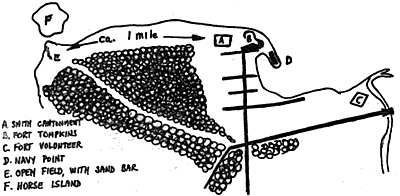The British squadron sailing on Lake Ontario delivered a party of approximately 8-900 British regulars to Sackets Harbor on 28 May 1813. The next day, the troops landed, tried to destroy the U.S. supply depot/navy yard, and succeeded in adding one more blotch on the record of the career of Lt. Gen. Sir George Prevost. There is no doubt that the raid was botched, but its timing was excellent (just when all attention was focused on an American attack on Fort George), and a reasonable margin for success existed. It is easy to blame Sir George for the failure. however, there is more to consider.
Although the total situation at Sackets Harbor may not lend itself easily to the gaming table, the combination of topography, weather, and forces do make Sackets Harbor an interesting topic for discussion, and perhaps some limited application to war-gaming. The map accompanying this article, while not of top quality, does show the relative position of forte and other defenses around the harbor area as they existed at the time of the attack.
 The usable landing areas existed at Horse Island (F), Navy
Point (D), and Fort Volunteer (C), however, the latter two points are
not practicable because of the defenses overlooking them. The rest of
the shoreline shown in the map is dominated by steep limestone bluffs,
one of' nature's own contributions to the defense of Sacketa Harbor.
(Sir George did land his troops on Horse Island, which is still
separated by only a shallow ford from the mainland.) Horse Island is
roughly one mile from the major supply depot and shipyard, a distance
covered on one side by forest and the other by precipitous shoreline.
The usable landing areas existed at Horse Island (F), Navy
Point (D), and Fort Volunteer (C), however, the latter two points are
not practicable because of the defenses overlooking them. The rest of
the shoreline shown in the map is dominated by steep limestone bluffs,
one of' nature's own contributions to the defense of Sacketa Harbor.
(Sir George did land his troops on Horse Island, which is still
separated by only a shallow ford from the mainland.) Horse Island is
roughly one mile from the major supply depot and shipyard, a distance
covered on one side by forest and the other by precipitous shoreline.
The defending force, under Major General Jacob Brown (New York State Militia), consisted of odd lots of regulars (300 men), recruits (100), and militia (600). The regular contingent contained men from the 2nd Light Dragoons, 9th, 21st. and 23rd Infantry Regiments, and the 3rd and Light Artillery Regiments. The regulars faced the enemy for almost the entire duration of the battle, as the militia showed that discretion was the better part of valor, until being brought back into the fight.
The attacking force, under Col. Edward Baynes in the field was made up of: the grenadier company of the 100th, a subaltern's detachment of the Royal Scots. 2 companies of the 8th, 4 companies of the 104th, 2 companies of Voltigeurs, a company of the Glengarry Light Infantry, two guns of the Royal Artillery, and roughly 40 Indians.
The weather of 29 May favored land operations, being sunny and typical for the late spring, but a contrary or non-existent wind kept the ships under Sir James Yeo from being able to support the expedition in any appreciable manner.
What happened is a matter of history, but, given this minimum of information and your knowledge of tactics, was the outcome to be expected, or was Jacob Brown extremely lucky in his first real test? There are more variables involved, but the location of the various forests, forts, and gun positions may dictate either stronger or more unique means of defense than were used. Furthermore, you may want to experiment with a slightly different order of battle, such as including two or three extra gun crews (without guns, in the hope that extra artillery can be captured from the militia), or improving the weather for the Navy's role. Also, there may be some role for disaffected Americans or zealous militiamen from more distant parts of the militia beat.
Back to Empire, Eagles, & Lions Table of Contents Vol. 1 No. 48
Back to EEL List of Issues
Back to MagWeb Master Magazine List
© Copyright 1980 by Jean Lochet
This article appears in MagWeb (Magazine Web) on the Internet World Wide Web.
Other military history articles and gaming articles are available at http://www.magweb.com
